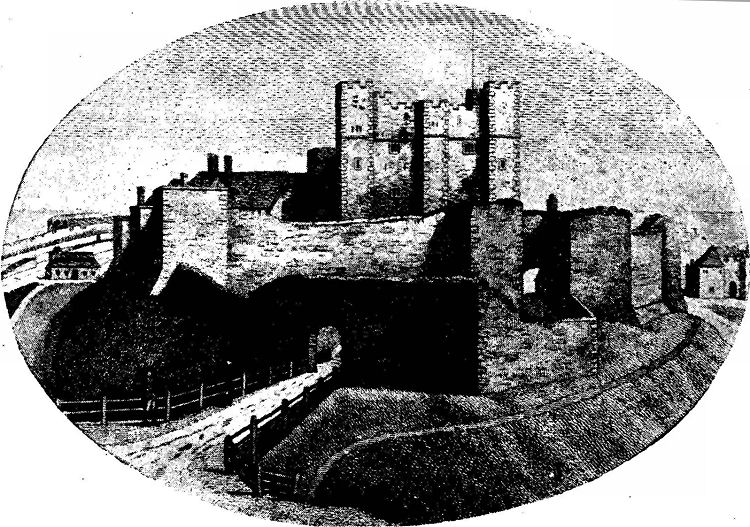Page Updated:- Sunday, 07 March, 2021. |
|||||
 Published in the Dover Express, 29 August, 1980. A PERAMBULATION OF THE TOWN, PORT AND FORTRESS. PART 109.
CINQUE PORTS CHARTER Things, too, were critical with the French—they bad been kept at bay for months, their supplies were running short and the winter was coming on, so that when John de Pencester and his brave band broke through to help the besiegers, the French lost hope, and the defenders of the Castle saved the fortress from the only great assault that was ever made upon it, and in doing that saved England from a French conquest. During the wars of the Barons, there were some quick changes at Dover Castle. In 1261, Henry III came there and ousted Hugh le Bigod from the Constableship, appointing Robert Walerand in his place. The latter was furnished with arms to defend the Castle against the Barons; also he received a mandate to take control of Dover harbour from the portsmen. Both arms and mandate were useless against the Barons, Henry de Mont-fort, supported by the Cinque Forts, got possession of the Castle as Constable, and he there received Prince Henry and Prince Edward as prisoners after the battle of Lewes. Prince Edward {afterwards King) was liberated on an exchange of prisoners. He immediately raised an army, laid siege to the Castle, and his friends, the prisoners within, getting control of the Keep, the whole Castle was soon surrendered to Prince Edward. That conquering prince did not retaliate, and a few years after, as King Edward I, he gave the Cinque Ports the grand charter, which was ever afterwards the guarantee of their rights and privileges. After the pacification of the Barons, four centuries passed, during which the visits of the various sovereigns were of a peaceful character. Edward I visited the Castle twice; and Edward H, Edward HI, Henry V, Henry VII, and Henry VIII were frequent visitors. Elizabeth visited the Castle twice. Charles I and Charles II were also visitors to the Castle. The visits of these monarchs were not always welcomed by the people of the neighbourhood; provisions of hay, straw and corn were exacted from the country folk to meet the requirements of the royal visitors and their followers; but as years went on, owing to public protests, this form of royal blackmail was minimised. Henry VIII took from the Constable the whole of his great estate, out of which the king obtained the revenues to build the castles of Sandown, Deal, Walmer and Sandgate, and the Moat Bulwark and Archcliffe Fort at Dover. Queen Elizabeth’s first visit, in August 1573, lasted a week and was mainly pageantry; and her second visit, in the autumn of 1601, was for a conference on the balance of power in Europe. Charles’ I’s visit to Dover Castle was to meet his proxy-wedded Queen Henrietta, of Prance. He lingered at Canterbury until the Queen had been carried up to the Castle on a litter and had had a night to recover from her seasickness, and then, with a great following of the nobility, he came to Dover to receive her, and it is a legend at the Castle that the royal pair first met on the grand staircase of the Keep.

Lucius, the first Christian King of ye Britains is said to have built this chapel soon after his conversion and endowed it with ye Toll of ye Haven. Thus reads the inscription below this 1735 engraving of the ruined castle church by Samuel and Nathaniel Buck.

This engraving of the church and Pharos at Dover Castle dates from 1810. In an inscription fears were expressed that the “venerable structure“ — then united with masonry as one building—might soon be demolished “ as there Is talk of building officers’ barracks on the site.“ Fortunately these were built elsewhere.

Above is a print of 1760 giving a view of the Castle from the north.
|
|||||
|
If anyone should have any a better picture than any on this page, or think I should add one they have, please email me at the following address:-
|
|||||
| LAST PAGE |
|
MENU PAGE |
|
NEXT PAGE | |